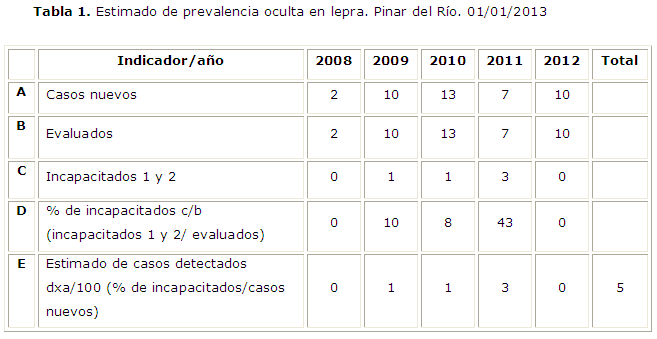Prevalence and Prognosis of Leprosy in Pinar del Río
Keywords:
Epidemiology, Leprosy/epidemiology.Abstract
Introduction: leprosy is a chronic, mildly contagious granulomatous disease caused by the bacillus Mycobacterium leprae, affecting chiefly the skin, the peripheral nerves, the mucosa of the upper respiratory tracts, the eyes and other structures.Objective: to estimate the real prevalence by the calculation of the hidden prevalence and the prognosis of leprosy in Pinar del Río for the year 2013.
Material and method: an observational descriptive study of prospective character was carried out; for obtaining the information, compulsory declaration cards and the epidemiological surveys of the leprosy cases were reviewed. Several indicators were calculated: leprosy prevalence rate, hidden prevalence, and the prognosis of the disease by the method of exponential smoothing.
Results: in the last years, the prevalence of leprosy in P. Rio has a tendency towards decrease, existing a difference between the known prevalence and the real prevalence, on the increase of the latter to the sum of the hidden prevalence of 5 cases, with a forecast in the disease for 2013 similar to the previous year.
Conclusion: the study revealed that although leprosy does not constitute a health problem in the Province, there are gaps in the surveillance system, identified after calculation of the estimate of hidden prevalence representing the number of leprosy cases, not diagnosed in the Province in the last five years, which will have an influence in the operational and epidemiological indicators of the leprosy program.
Downloads
References
1. De Guzman M T, Cortes I, Zabaleta J P, Aramburu J A. A male from Brazil presenting skin lesions and fever. Enferm Infecc Microbiol Clin [internet]. 2009[citado 2013 abr 2];27(7):[aprox.2p.].Disponible en: http://zl.elsevier.es/es/revista/enfermedades-infecciosas-microbiologia-clinica-28/articulo/varon-natural-brasil-que-consulta-13140305
2. Carvalhal Frazão Corrêa RG, Cardoso de Aquino DM, Mendes Caldas AJ, Carneiro Rêgo Amara DK, Silva França F, Rêgo Barros Pires-Leal Mesquita ER. Aspectos epidemiológicos, clínicos e operacionais de portadores de hanseníase atendidos em um serviço de referência no estado do Maranhão. Rev. Soc. Bras. Med. Trop.[internet] 2012[citado 2013 Abr 4]:45 (1):[aprox. 25p.]. Disponible en: http://dx.doi.org/10.1590/S0037-86822012000100017.
3. Arenas R. Dermatología: Atlas, Diagnóstico y Tratamiento. 4th ed. México: McGraw-Hill; 2009:411-426.
4. Rivero Reyes E, Barrios Martínez Z, Berdasquera Corcho D, Tápanes Fernández T, Peñalver Sinchay AG. La lepra, un problema de salud global. Rev Cubana Med Gen Integr[internet]. 2009[citado 2013 abr 2]; 25(1):[aprox.6p.]. Disponible en: http://scielo.sld.cu/scielo.php?script=sci_arttext&pid=S0864-21252009000100010&lng=es.
5. Torres Guerrero E, Vargas Martínez F, Atoche Diéguez CE, Aráosla J, Arenas Guzmán R. Lepra. Clasificación y cuadro clínico. Dermatol Rev Mex [internet]. 2012[citado 2013 abr 5];56 (1):[aprox.17p.]. Disponible en:
http://www.medigraphic.com/pdfs/derrevmex/rmd-2012/rmd121g.pdf
6. Soprani dos Santos A, Silveira de Castro D, Falqueto A. Fatores de risco para transmissão da Hanseníase. Rev Bras enferm Brasília [internet] 2008[citado 2013 abr 5]; 61:[aprox.15p.]. Disponible en: http://www.scielo.br/pdf/reben/v61nspe/a14v61esp.pdf
7. Meira Alves CJ, Barreto JA, Fogagnolo L, Arsie Contin L, Wolf Nassif P. Evaluation of the degree of incapacity of patients with a diagnosis of leprosy at a dermatology service in the state of São Paulo. Rev. Soc. Bras. Med. Trop.[internet] 2010 July/Aug[citado 2013 abr 5]; 43 (4): [aprox. 1p.]. Disponible en: http://dx.doi.org/10.1590/S0037-86822010000400025.
8. Cuba. MINSAP. Lepra. Normas técnicas para el control y tratamiento. La Habana: Ciencias Médicas; 2008.
9. Rodríguez E, O. Díaz O, Hernández G. Vigilancia de la lepra. Situación en el mundo y en España, 2010. Boletín epidemiológico.[internet] 2010[citado 2013 abr 6]; 18 (21):[aprox. 11p.]. Disponible en: http://revista.isciii.es/index.php/bes/article/viewArticle/256.
10. Félix Lana FC, Mendes Carvalho AP, Ferraz Lopez DR. Perfil epidemiológico de la lepra en la micro región de araçuaí y su relación con las acciones de control. Esc Anna Nery[internet]. 2011 jan-mar[citado 2013 abr 5]; 15 (1):[aprox.5p.]. Disponible en: http://www.scielo.br/pdf/ean/v15n1/09.pdf
11. Cardona Castro NM, Bedoya Berrío G. Lepra: enfermedad milenaria y actual. Rev Iatreia[internet]. 2011[citado 2013 abr 4]; 24 (1): [aprox.25p.]. Disponible en:
http://www.scielo.org.co/scielo.php?pid=S012107932011000100006&script=sci_arttext&tlng=en
12. Álvarez Yabor VJ, Morales Solís M, González Rodríguez A, Peña Pérez O. Caracterización de la lepra en la provincia de Las Tunas en el quinquenio 2004 - 2008. Rev modules [internet]. 2010 abri-junio[citado 2013 abr 4];35(2):[aprox.22p.]. Disponible en: http://www.ltu.sld.cu/revista/modules.php?name=News&file=article&sid=98http://www.ltu.sld.cu/revista/modules.php?name=News&file=article&sid=9.
13. Hidalgo Pereira FI, Martínez López G, Fernández Juviel AI. Situación epidemiológica de la lepra en Cumanayagua (2006-2011): estudio de cohorte retrospectiva. Medwave[internet]. 2012 Dic [citado 2013 abr 5];12(11):[aprox.6p.]. Disponible en:
http://www.mednet.cl/link.cgi/Medwave/Estudios/Investigacion/5578.

Published
How to Cite
Issue
Section
License
Authors who have publications with this journal agree to the following terms: Authors will retain their copyrights and grant the journal the right of first publication of their work, which will be publication of their work, which will be simultaneously subject to the Creative Commons Attribution License (CC-BY-NC 4.0) that allows third parties to share the work as long as its author and first publication in this journal are indicated.
Authors may adopt other non-exclusive license agreements for distribution of the published version of the work (e.g.: deposit it in an institutional telematic archive or publish it in a volume). Likewise, and according to the recommendations of the Medical Sciences Editorial (ECIMED), authors must declare in each article their contribution according to the CRediT taxonomy (contributor roles). This taxonomy includes 14 roles, which can be used to represent the tasks typically performed by contributors in scientific academic production. It should be consulted in monograph) whenever initial publication in this journal is indicated. Authors are allowed and encouraged to disseminate their work through the Internet (e.g., in institutional telematic archives or on their web page) before and during the submission process, which may produce interesting exchanges and increase citations of the published work. (See The effect of open access). https://casrai.org/credit/


